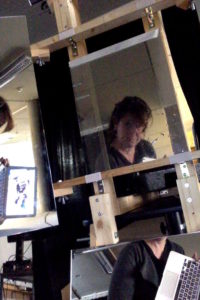Invisible
An international collaboration across the UK and Brazil between Rachel Jacobs, Silvia Leal and Flor de Pequi.
Funded by Horizon, University of Nottingham.
The aim of the research elements of the project was to explore how we might use interactive mirror technologies to develop a new artwork/mobile performance lab. We started with using existing technologies that were developed by the Mixed Reality Lab/Horizon in partnership with Unilever and then developed these technologies towards open source, accessible tools for building a new artwork.
The artwork was developed in parallel to this research. Artist/researchers Rachel Jacobs and Silvia Leal explored how they might intervene with contested environments and build collaborations with communities in these environments using interactive mirrored and reflective surfaces. Rachel has been working with a local community through a residency at Primary Studios in Nottingham, close to the Jubilee Campus at the University. In parallel Silvia has been working with a community in Bomfim, Pirenópolis, Brazil developing a partnership with the unique arts organisation Flor de Pequi.
After a series of workshops with artists, students, researchers and local people, the team in the UK -Rachel, Nils Jager, Holger Schnadelbach, Antony Brown (Horizon) and Robin Shackford (an ongoing collaborator with Rachel and Silvia) presented a prototype interactive mirror sculpture at a public event in Primary. This experience weaved narratives written, developed and devised by Rachel, Silvia and Robin in response to the environments they had been working in and dialogues with the communities. The sculpture, based on an old fashioned bellows camera, aimed to reflect multiple visions of the environment where it was placed and draw audiences into the narrative that unfolded through a central semi-transparent mirror.
250 people attended the event and approximately 50 people interacted directly with the sculpture, with individuals spending time going through the full narrative experience (lasting 8 minutes), couples walking towards the experience together and taking it in turns to interact, and groups playing with ways that the narrative and masks attached themselved to their reflected bodies, turning the experience into a playful game between audience members and the environment where they stood.
This presentation raised many challenges around the technology and creative process, leading to a new phase of experimentation for the UK team, exploring different ways to track audiences, create interactions through the semi-transparent mirrored surface and build the narratives for these interactions. It has also led to a creating a portable mirror sculpture in an old suitcase.
Meanwhile in Brazil Silvia visited Pirenópolis. Described here in her own words:
“My time spent at the Guaimbê centre, meeting the people, and those who it involves, the specificity of that particular community of Bomfim. Led me to a beautiful introduction to the ambitions and methodologies, only be really understood through the physical experience of playing and dancing amongst Flor de Pequi. Although my first proper conversation with Daraína about the work I wanted to develop with them, came after a chinese movement class which takes place every monday, wednesday and friday at 8am sharp. I found myself with 8 other women and one man all of whom age over 70 years.
Since our time together in December, I have been in frequent communication with Daraíana about what the work we have started sketching out together will lead us next, highlighting the synergies between the Invisible project and their recent work the Memorial de Ossos, the performance variations. How together we can produce a mobile and analog cased mirror to link up with England, a community not yet identified, but likely to be in the midlands, of a mining tradition.
I went to Pirenópolis with a personal quest to find out about the masked tradition, the stories and subjects behind it. Their materiality, the people who make them, wear them, the elders, the story-tellers. As a result Daraína wrote a proposal to our collaboration as a continuation of Memorial do Ossos, entitled Curucucu. The central character which has inspired our conversations and is a really interesting bridge-builder to connect our stories and ambition between UK and Brasil.”
Two suitcases were created. In the UK the suitcase had technology and mirrors inside, to be introduced to an ex-mining community in Nottinghamshire to start a conversation about future work. The second suitcase in Brazil is covered in gold leaf, the biggest mined export of Brazil to the UK, with reflective surfaces inside and analogue props to inspire future performance experiments with Flor de Pequi.
Finally, The Invisible installation at the Primary Studios, an artist studio space and public gallery in the Lenton area of Nottingham. It took place as part of Primary’s Uncanny Christmas in December 2016 a party with dj’s, art exhibitions and bars all around the building. The Invisible interactive mirror was installed in a doorway leading off the playground with a walkway between the playground and the main gallery space at Primary Studios, where DJs and other art exhibitions were taking place, as part of the event and. The event took place between 7-11pm at night.
The Invisible mirror faced out of the doorway, reflecting the dark playground beyond. It was installed alongside a gazebo with two fires, hay bales for people to sit and chat and mulled wine. 250 people attended the wider event. Approximately 50 people interacted directly with the mirror with possibly another 100 people watching and interacting briefly as they walked past. The installation was presented as an experiment for people to play and engage with. The aim of the
event was to explore how people might interact with the technology and the artistic experience, how people responded to the concept of multiple mirrored surfaces, the elements of interaction embedded in them, and how they related to the stories that were revealed through these interactions.













